The In-Memory Database Market is estimated to be valued at USD 7.1 billion in 2025 and is projected to reach USD 26.2 billion by 2035, registering a compound annual growth rate (CAGR) of 14.0% over the forecast period.
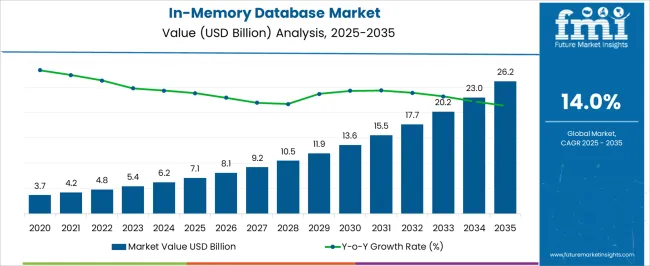
| Metric | Value |
|---|---|
| In-Memory Database Market Estimated Value in (2025 E) | USD 7.1 billion |
| In-Memory Database Market Forecast Value in (2035 F) | USD 26.2 billion |
| Forecast CAGR (2025 to 2035) | 14.0% |
The In-Memory Database market is experiencing significant growth, driven by the increasing need for real-time data processing and analytics across multiple industries. Organizations are prioritizing high-speed data access to enhance operational efficiency, optimize decision-making, and support digital transformation initiatives. Adoption is being accelerated by advancements in in-memory computing technologies, which allow databases to store and retrieve data directly from system memory, significantly reducing latency compared to traditional disk-based systems.
Demand is particularly strong in industries that require immediate transaction processing, predictive analytics, and large-scale data analysis. Integration with cloud platforms, AI, and machine learning systems is enhancing performance and scalability, enabling organizations to handle complex workloads more efficiently.
Regulatory compliance, the need for fraud detection, and the growing adoption of omnichannel customer experiences further support market growth As enterprises continue to embrace real-time analytics and data-driven decision-making, the in-memory database market is poised for sustained expansion, driven by innovation in memory technologies, high-performance computing, and software optimization.
The in-memory database market is segmented by data type, vertical, application, and geographic regions. By data type, in-memory database market is divided into Relational Data Type, SQL, and NEWSQL. In terms of vertical, in-memory database market is classified into BFSI, Retail, Telecomm, Health Care, Energy, Education, Automobile, Public Sector, and Others. Based on application, in-memory database market is segmented into Transaction, Reporting, and Analytics. Regionally, the in-memory database industry is classified into North America, Latin America, Western Europe, Eastern Europe, Balkan & Baltic Countries, Russia & Belarus, Central Asia, East Asia, South Asia & Pacific, and the Middle East & Africa.
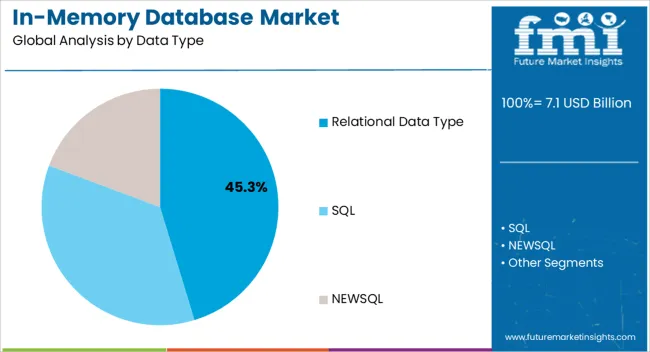
The relational data type segment is projected to hold 45.3% of the market revenue in 2025, establishing it as the leading data type. Its dominance is being driven by the widespread use of structured data models that allow for organized storage, easy querying, and efficient transaction processing. Relational in-memory databases provide fast access to large volumes of structured data, enabling real-time analytics and decision-making.
Organizations leverage these databases for consistency, reliability, and compliance with governance standards, particularly in industries with complex transactional requirements. The ability to integrate with existing enterprise applications, such as ERP and CRM systems, further strengthens adoption.
Continuous improvements in query optimization, indexing, and memory management enhance performance and reduce operational costs As businesses increasingly prioritize data-driven strategies and demand faster processing speeds for structured datasets, the relational data type segment is expected to maintain its market leadership, supported by high scalability, operational efficiency, and robust integration capabilities.
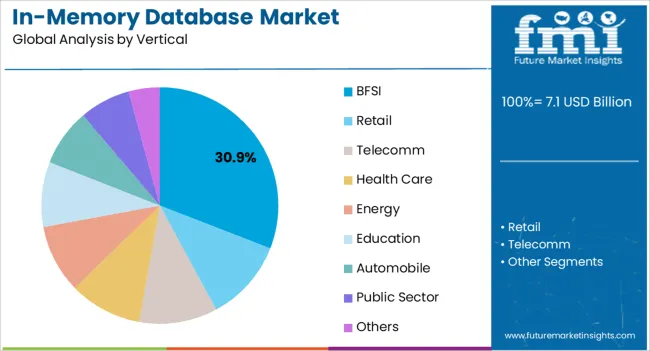
The BFSI vertical segment is expected to account for 30.9% of the market revenue in 2025, making it the leading vertical. Growth is being driven by the critical need for real-time transaction processing, risk management, fraud detection, and regulatory compliance. Financial institutions are increasingly adopting in-memory databases to enable rapid processing of massive datasets while ensuring accuracy and reliability.
The ability to perform real-time analytics on structured and unstructured data allows for enhanced decision-making, faster reporting, and improved customer experiences. Integration with AI and machine learning applications provides predictive insights for credit scoring, portfolio management, and fraud mitigation.
Increasing digitization in banking, insurance, and investment sectors, coupled with the need for immediate response to market changes, further reinforces adoption As financial services continue to demand speed, efficiency, and reliability in data management, the BFSI vertical is expected to maintain its leadership as a primary driver of market growth.
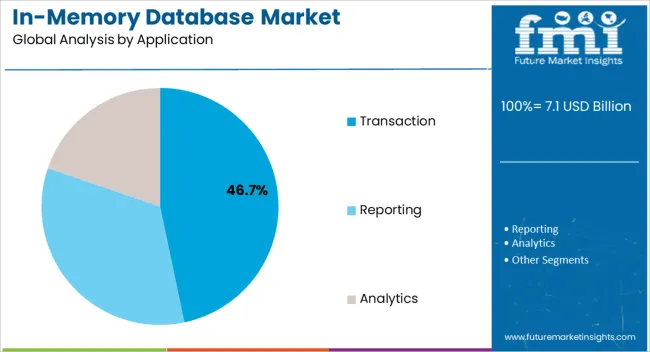
The transaction application segment is projected to hold 46.7% of the market revenue in 2025, establishing it as the leading application area. Growth is being driven by the need for real-time processing of large volumes of transactions across sectors such as banking, retail, and e-commerce. In-memory databases provide high-speed data access and low-latency performance, enabling organizations to handle transactional workloads efficiently while maintaining data consistency and accuracy.
The ability to support concurrent transactions, rapid query execution, and complex analytics in real time enhances operational efficiency and decision-making. Increasing demand for fraud detection, instant payment processing, and omnichannel customer experiences further strengthens adoption.
Organizations are leveraging in-memory databases to reduce operational costs, minimize downtime, and enhance performance for high-throughput transactional environments As digital transformation accelerates across industries, the transaction application segment is expected to remain the primary driver of market growth, supported by continued innovations in in-memory computing and database management technologies.
In-memory databases are faster than traditional databases which is a part of the computer main memory and need just fewer instructions to access the data for reading and writing. In-memory databases are primarily used in business analytics and big data management where there is need for fast data access and storage.
Another advantage of in-memory database system is its application in real-time embedded systems which are highly resource constrained which require small memory and have low processor computational capabilities.
Primary factor which benefit organizations through the use of in-memory database was the performance.
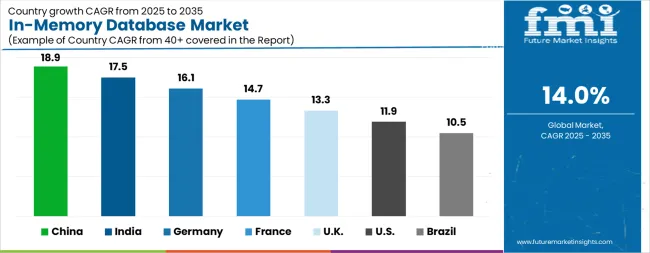
| Country | CAGR |
|---|---|
| China | 18.9% |
| India | 17.5% |
| Germany | 16.1% |
| France | 14.7% |
| UK | 13.3% |
| USA | 11.9% |
| Brazil | 10.5% |
The In-Memory Database Market is expected to register a CAGR of 14.0% during the forecast period, exhibiting varied country level momentum. China leads with the highest CAGR of 18.9%, followed by India at 17.5%. Developed markets such as Germany, France, and the UK continue to expand steadily, while the USA is likely to grow at consistent rates. Brazil posts the lowest CAGR at 10.5%, yet still underscores a broadly positive trajectory for the global In-Memory Database Market. In 2024, Germany held a dominant revenue in the Western Europe market and is expected to grow with a CAGR of 16.1%. The USA In-Memory Database Market is estimated to be valued at USD 2.7 billion in 2025 and is anticipated to reach a valuation of USD 8.2 billion by 2035. Sales are projected to rise at a CAGR of 11.9% over the forecast period between 2025 and 2035. While Japan and South Korea markets are estimated to be valued at USD 328.0 million and USD 237.2 million respectively in 2025.
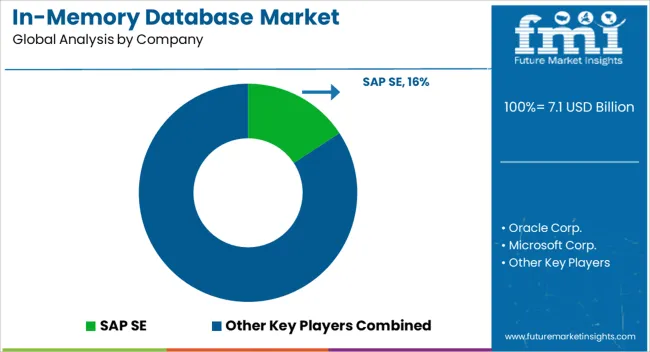
| Item | Value |
|---|---|
| Quantitative Units | USD 7.1 Billion |
| Data Type | Relational Data Type, SQL, and NEWSQL |
| Vertical | BFSI, Retail, Telecomm, Health Care, Energy, Education, Automobile, Public Sector, and Others |
| Application | Transaction, Reporting, and Analytics |
| Regions Covered | North America, Europe, Asia-Pacific, Latin America, Middle East & Africa |
| Country Covered | United States, Canada, Germany, France, United Kingdom, China, Japan, India, Brazil, South Africa |
| Key Companies Profiled | SAP SE, Oracle Corp., Microsoft Corp., IBM Corp., Redis Ltd. (Redis Enterprise), Aerospike Inc., VoltDB Inc., Couchbase Inc., DataStax Inc., Hazelcast Inc., MemVerge Inc., Altibase Corp., and GridGain Systems Inc. |
The global in-memory database market is estimated to be valued at USD 7.1 billion in 2025.
The market size for the in-memory database market is projected to reach USD 26.2 billion by 2035.
The in-memory database market is expected to grow at a 14.0% CAGR between 2025 and 2035.
The key product types in in-memory database market are relational data type, sql and newsql.
In terms of vertical, bfsi segment to command 30.9% share in the in-memory database market in 2025.






Our Research Products

The "Full Research Suite" delivers actionable market intel, deep dives on markets or technologies, so clients act faster, cut risk, and unlock growth.

The Leaderboard benchmarks and ranks top vendors, classifying them as Established Leaders, Leading Challengers, or Disruptors & Challengers.

Locates where complements amplify value and substitutes erode it, forecasting net impact by horizon

We deliver granular, decision-grade intel: market sizing, 5-year forecasts, pricing, adoption, usage, revenue, and operational KPIs—plus competitor tracking, regulation, and value chains—across 60 countries broadly.

Spot the shifts before they hit your P&L. We track inflection points, adoption curves, pricing moves, and ecosystem plays to show where demand is heading, why it is changing, and what to do next across high-growth markets and disruptive tech

Real-time reads of user behavior. We track shifting priorities, perceptions of today’s and next-gen services, and provider experience, then pace how fast tech moves from trial to adoption, blending buyer, consumer, and channel inputs with social signals (#WhySwitch, #UX).

Partner with our analyst team to build a custom report designed around your business priorities. From analysing market trends to assessing competitors or crafting bespoke datasets, we tailor insights to your needs.
Supplier Intelligence
Discovery & Profiling
Capacity & Footprint
Performance & Risk
Compliance & Governance
Commercial Readiness
Who Supplies Whom
Scorecards & Shortlists
Playbooks & Docs
Category Intelligence
Definition & Scope
Demand & Use Cases
Cost Drivers
Market Structure
Supply Chain Map
Trade & Policy
Operating Norms
Deliverables
Buyer Intelligence
Account Basics
Spend & Scope
Procurement Model
Vendor Requirements
Terms & Policies
Entry Strategy
Pain Points & Triggers
Outputs
Pricing Analysis
Benchmarks
Trends
Should-Cost
Indexation
Landed Cost
Commercial Terms
Deliverables
Brand Analysis
Positioning & Value Prop
Share & Presence
Customer Evidence
Go-to-Market
Digital & Reputation
Compliance & Trust
KPIs & Gaps
Outputs
Full Research Suite comprises of:
Market outlook & trends analysis
Interviews & case studies
Strategic recommendations
Vendor profiles & capabilities analysis
5-year forecasts
8 regions and 60+ country-level data splits
Market segment data splits
12 months of continuous data updates
DELIVERED AS:
PDF EXCEL ONLINE
Database Monitoring – AI & Automation for Performance Optimization
Graph Database Market Size and Share Forecast Outlook 2025 to 2035
Cloud Database and DBaaS Market Size and Share Forecast Outlook 2025 to 2035
No SQL Database Market
Managed Database Services Market Report - Growth & Forecast 2025 to 2035

Thank you!
You will receive an email from our Business Development Manager. Please be sure to check your SPAM/JUNK folder too.
Chat With
MaRIA